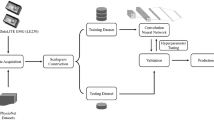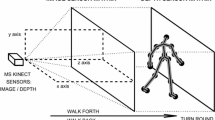Abstract
Sensor-based systems for diagnosis or therapy support of motor dysfunctions need methodologies of automatically stride detection from movement sequences. In this proposal, we developed a stride detection system for daily life use. We compared mostly used algorithms min–max patterns, dynamic time warping, convolutional neural networks (CNN), and automatic framing using two data sets of 32 healthy and 28 Parkinson’s disease (PD) persons. We developed an insole with force and IMU sensors to record the gait data. The PD patients carried out the standardized time up and go test, and the healthy persons a daily life activities test (walking, sitting, standing, ascending and descending stairs). As an automatically stride detection process for daily life use, we propose a first stride detection using automatic framing, and after normalization and resampling data a CNN is used. A F1-score of 0.938 (recall 0.968, precision 0.910) for time up and go test and of 0.944 (recall 0.992, precision 0.901) for daily life activities test were obtained for CNN. Compared to the other detection methods, up to 6% F-measure improvement was shown.












Similar content being viewed by others
References
Ball N et al (2019) Parkinson’s disease and the environment. Front. Neurol. 10:218
Pachoulakis, I., Papadopoulos, N.: Exergames for Parkinson’s disease patients: the balloon goon game. In: 2016 International Conference on Telecommunications and Multimedia (TEMU). IEEE (2016)
Kovač J, Štruc V, Peer P (2019) Frame-based classification for cross-speed gait recognition. Multimed. Tools Appl. 78(5):5621–5643
Kovač J, Peer P (2014) Human skeleton model based dynamic features for walking speed invariant gait recognition. Math Probl Eng 2014:484320
Kovač J, Peer P (2013) Transformation based walking speed normalization for gait recognition. KSII Trans Internet Inf Syst 7(11):2690–2701
Seckiner D, Mallett X, Maynard P, Meuwly D, Roux C (2019) Forensic gait analysis—morphometric assessment from surveillance footage. Forensic Sci Int 296:57–66
Ng H, Tong HL, Tan WH, Yap TTV, Chong PF, Abdullah J (2011) Human identification based on extracted gait features. Int. J. New Comput. Archit. Appl. (IJNCAA) 1(2):358–370
Rastegari, E., Azizian, S., Ali, H.: Machine learning and similarity network approaches to support automatic classification of Parkinson’s diseases using accelerometer-based gait analysis. In: Proceedings of the 52nd Hawaii International Conference on System Sciences (2019)
Prakash, C., Sujil, A., Kumar, R., Mittal, N.: Linear prediction model for joint movement of lower extremity. In: Recent Findings in Intelligent Computing Techniques, pp. 235–243. Springer, Singapore (2019)
Gupta, U., Bansal, H., Joshi, D.: Gender specific and age dependent classification model for improved diagnosis in Parkinson’s disease. arXiv preprint arXiv:1904.09651 (2019)
Espay AJ et al (2016) Technology in Parkinson’s disease: challenges and opportunities. Mov. Disord. 31(9):1272–1282
Barth J et al (2015) Stride segmentation during free walk movements using multi-dimensional subsequence dynamic time warping on inertial sensor data. Sensors 15(3):6419–6440
Bobić, V.N., et al.: Challenges of stride segmentation and their implementation for impaired gait. In: 2018 40th Annual International Conference of the IEEE Engineering in Medicine and Biology Society (EMBC). IEEE (2018)
Tao X et al (2018) Precise displacement estimation from time-differenced carrier phase to improve PDR performance. IEEE Sensors J. 18(20):8238–8246
Koroglu, M.T., Yilmaz, A., Saul, C.J.: A deep learning strategy for stride detection. In: 2018 IEEE sensors. IEEE (2018)
Hannink J et al (2018) Mobile stride length estimation with deep convolutional neural networks. IEEE J. Biomed. Health Inf. 22(2):354–362
Watanabe, T., Miyazawa, T., Shibasaki, J.: A study on IMU-based stride length estimation for motor disabled subjects: a comparison under different calculation methods of rotation matrix. In: 2018 IEEE EMBS International Conference on Biomedical and Health Informatics (BHI). IEEE (2018)
Kim, Y., Eyobu, O.S., Han, D.S.: ANN-based stride detection using smartphones for Pedestrian dead reckoning. In: 2018 IEEE International Conference on Consumer Electronics (ICCE). IEEE (2018)
Jiang, X., et al.: Exploration of gait parameters affecting the accuracy of force myography-based gait phase detection. In: 2018 7th IEEE International Conference on Biomedical Robotics and Biomechatronics (Biorob). IEEE (2018)
Ince, O.F., et al.: Gait analysis and identification based on joint information using RGB-depth camera. In: 14th International Conference on Electrical Engineering/Electronics. Computer, Telecommunications and Information Technology (ECTI-CON). IEEE (2017)
Agostini V, Balestra G, Knaflitz M (2014) Segmentation and classification of gait cycles. IEEE Trans. Neural Syst. Rehabil. Eng. 22(5):946–952
Mazumder, O., et al.: Assessment of insole based gait feature variation with progression of Parkinson’s disease. In: 2018 IEEE Sensors. IEEE (2018)
Steinmetzer, T., et al.: Clustering of human gait with Parkinson’s disease by using dynamic time warping. In: 2018 IEEE International Work Conference on Bioinspired Intelligence (IWOBI). IEEE (2018)
Muheidat, F., et al.: Estimating walking speed, stride length, and stride time using a passive floor based electronic scavenging system. In: 2017 IEEE Sensors Applications Symposium (SAS). IEEE (2017)
Gwak, M., Sarrafzadeh, M., Woo, E.: Support for a clinical diagnosis of mild cognitive impairment using photoplethysmography and gait sensors. In: Proceedings, APSIPA Annual Summit and Conference, vol. 2018 (2018)
Hoehn MM, Yahr MD (1967) Parkinsonism: onset, progression, and mortality. Neurology 17(5):427–427
Goetz CG et al (2008) Movement disorder society-sponsored revision of the unified Parkinson’s disease rating scale (MDS-UPDRS): scale presentation and clinimetric testing results. Mov. Disorders 23(15):2129–2170
Frochte J (2019) Maschinelles Lernen: Grundlagen und Algorithmen in Python. Carl Hanser Verlag GmbH Co KG, Munich
Hausdorff JM et al (1998) Gait variability and basal ganglia disorders: stride-to-stride variations of gait cycle timing in Parkinson’s disease and Huntington’s disease. Mov. Disorders 13(3):428–437
Keogh E, Ratanamahatana CA (2005) Exact indexing of dynamic time warping. Knowl. Inf. Syst. 7(3):358–386
Abadi, M., et al.: Tensorflow: a system for large-scale machine learning. In: 12th USENIX Symposium on Operating Systems Design and Implementation (OSDI 16) (2016)
Sze V et al (2017) Efficient processing of deep neural networks: a tutorial and survey. Proc. IEEE 105(12):2295–2329
Srivastava N et al (2014) Dropout: a simple way to prevent neural networks from overfitting. J. Mach. Learn. Res. 15(1):1929–1958
Author information
Authors and Affiliations
Corresponding author
Additional information
Publisher's Note
Springer Nature remains neutral with regard to jurisdictional claims in published maps and institutional affiliations.
Rights and permissions
About this article
Cite this article
Steinmetzer, T., Bönninger, I., Reckhardt, M. et al. Comparison of algorithms and classifiers for stride detection using wearables. Neural Comput & Applic 32, 17857–17868 (2020). https://doi.org/10.1007/s00521-019-04384-6
Received:
Accepted:
Published:
Issue Date:
DOI: https://doi.org/10.1007/s00521-019-04384-6




